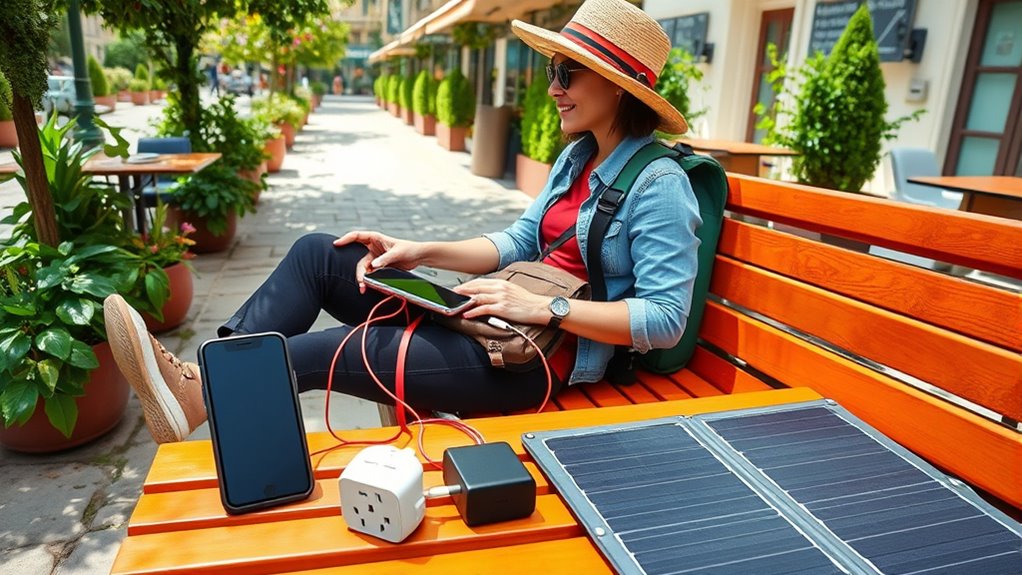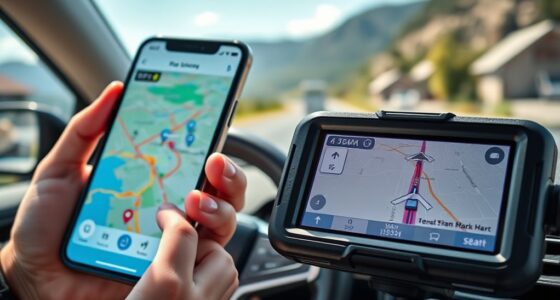To keep your devices charged while traveling, pack portable power banks with solar panels or wireless charging options for convenience on the go. Use car chargers and power adapters compatible with your vehicle, and optimize battery settings like low power modes to extend usage. Choose compact, travel-friendly accessories and plan charging stops at cafes or rest stops along your route. Keep these tips in mind, and you’ll discover even more ways to stay powered throughout your trip.
Key Takeaways
- Carry portable power banks with sufficient capacity and solar features for eco-friendly outdoor charging.
- Use vehicle’s USB ports or car chargers to recharge devices during drives.
- Enable battery saver modes and disable unused features like Bluetooth and location services.
- Bring travel-friendly accessories such as wireless chargers and compact solar panels.
- Plan and identify charging stations at your destination and along travel routes.
Pack Portable Power Banks

Packing portable power banks is essential for keeping your devices charged on the go. Look for power banks that incorporate solar panels—these can harness sunlight to recharge themselves, providing an eco-friendly backup when you’re away from outlets. Wireless charging-capable power banks are also convenient, allowing you to simply place your phone or compatible device on top without fiddling with cables. This feature is especially useful during travel, saving time and reducing clutter. Choose a portable power bank with enough capacity to handle multiple charges for your devices. Guarantee it’s lightweight and compact, so it fits easily in your bag. For longer trips, consider models with high-capacity batteries, which can provide multiple charges for your devices before needing a recharge themselves. By selecting models with solar panels and wireless charging, you’re better prepared for long trips, outdoor adventures, or situations where power outlets are scarce. Incorporating power bank capacity considerations ensures your devices stay powered throughout your journey. Additionally, selecting a power bank with fast-charging technology can help you quickly recharge your devices when time is limited. To maximize your device’s longevity, look for power banks that include overcharge protection features to prevent damage during charging. Implementing multi-device compatibility can also streamline your charging process when managing multiple gadgets.
Utilize Car Chargers and Power Adapters

Utilizing car chargers and power adapters is a practical way to keep your devices powered during road trips or commutes. Before you start, check your vehicle compatibility to make certain the charger or adapter fits your car’s power outlet types, such as standard cigarette lighter sockets or USB ports. Many modern vehicles feature built-in USB ports, making charging even easier without extra adapters. For older vehicles, a universal car charger with multiple ports can be a great investment. These chargers convert your vehicle’s power outlet into a charging station for smartphones, tablets, and other devices. Always choose a charger compatible with your device’s power needs to avoid overcharging or damage. With the right car charger or power adapter, you can stay connected without worrying about running out of battery on the go.
Optimize Battery Usage Settings

To extend your device’s battery life while traveling, adjusting your battery usage settings is essential. Enable low power or battery saver modes to reduce background activity, screen brightness, and unnecessary notifications, which helps preserve battery health. Turn off location services and Bluetooth when not in use to prevent extra drain. Limiting app refresh and auto-updates also conserves power, ensuring your device stays charged longer. These adjustments optimize charging speed by preventing rapid battery depletion, especially during long days on the go. Regularly reviewing your battery usage can identify power-hungry apps, allowing you to manage them proactively. Additionally, understanding sound healing science can inspire you to incorporate calming sounds into your environment, helping you relax and conserve energy during travel. Being aware of battery health maintenance strategies can further prolong your device’s overall lifespan. For example, keeping your device at optimal charge levels prevents unnecessary wear and tear on the battery. Incorporating power management settings can help you better control energy consumption across your device. Utilizing software updates can also improve battery efficiency through optimized performance. By fine-tuning these settings, you maximize your device’s longevity, making sure it remains functional throughout your travels without sacrificing performance.
Choose Travel-Friendly Charging Accessories

Choosing the right travel-friendly charging accessories guarantees your devices stay powered without adding bulk to your luggage. A portable solar panel is a smart option, especially if you’ll be outdoors or in remote areas, as it harnesses sunlight to recharge your devices on the go. Wireless charging pads are also convenient, eliminating the need for multiple cables and making it easy to top up your phone or earbuds quickly. Look for compact, lightweight options designed for travel, and verify they’re compatible with your devices. Combining a solar panel with a wireless charger provides flexibility and energy independence, helping you stay connected without relying solely on power outlets. Additionally, considering smart‑home integrations can enhance your charging setup by allowing remote monitoring and control of your devices. These accessories keep your gear charged efficiently, no matter where your adventures take you. Incorporating relationship concepts like open communication and trust can also ensure that sharing and managing charging resources with travel companions remains smooth and stress-free.
Plan Charging Stops During Your Journey

Planning your charging stops during the journey guarantees your devices stay powered without last-minute scrambling. Start by researching power outlet locations at your destinations and along your route using travel apps. This way, you know where to recharge without stress. To make it easier, consider these steps:
Plan your charging stops ahead to stay powered without stress during your trip.
- Map out key power outlet spots in cafes, airports, or rest stops before your trip.
- Set reminders on travel apps to alert you when it’s time to find a charging station.
- Prioritize stops where you can relax and recharge both yourself and your devices.
Frequently Asked Questions
Can Solar Chargers Effectively Power Devices During Travel?
Yes, solar chargers can effectively power your devices during travel. Their efficiency depends on the solar panel quality and sunlight availability. High-efficiency solar panels convert sunlight better, providing more power. Pairing solar chargers with portable power banks ensures you have backup energy when sunlight isn’t enough. This way, you stay connected and charged, making solar chargers a reliable, eco-friendly option for keeping your devices powered on the go.
What Are the Best Practices for Charging Multiple Devices Simultaneously?
You should use a reliable charging hub or power strip to charge multiple devices simultaneously. Plug your devices into a high-quality power strip with enough outlets, ensuring it’s compatible with your devices’ power needs. Opt for a charging hub with fast-charging ports to save time. Keep cables organized and avoid overloading the power strip to prevent overheating. This way, you keep all your devices powered efficiently during your trip.
How Do Extreme Temperatures Affect Device Battery Performance?
Extreme temperatures substantially impact your device’s battery performance. Cold temperatures can cause rapid battery drain and accelerate battery degradation over time, while hot temperatures may lead to overheating, reducing efficiency and damaging internal components. To protect your device, avoid exposing it to extreme heat or cold, and keep it in a cool, dry place. Proper temperature management helps preserve your battery’s lifespan and maintains ideal performance.
Are There Lightweight, Eco-Friendly Charging Options Available?
Yes, you can find lightweight, eco-friendly charging options like portable power banks made from sustainable materials and wireless charging pads that reduce cable waste. These options are perfect for travel because they’re compact, easy to carry, and environmentally conscious. You just need to choose a power bank with a high capacity or a wireless charger compatible with your devices, ensuring you stay powered up without harming the planet.
How Can I Extend My Device’s Battery Life During Long Travel Days?
To extend your device’s battery life during long travel days, use power saving tips like dimming your screen, turning off unnecessary notifications, and enabling airplane mode when not in use. Regular battery maintenance helps prevent rapid drain, so avoid letting your battery fully deplete. Carry portable chargers and unplug devices when fully charged. These habits keep your device powered longer, ensuring you stay connected throughout your journey.
Conclusion
Think of your devices as a garden that needs constant watering. By packing power banks, using car chargers, and optimizing settings, you’ll keep your devices thriving throughout your trip. Planning charging stops is like watering your plants at just the right moments—ensuring everything stays fresh and functional. With these simple steps, your devices will stay energized and ready to capture memories or guide you wherever you go. Travel confidently, knowing your devices are always charged and alive.









